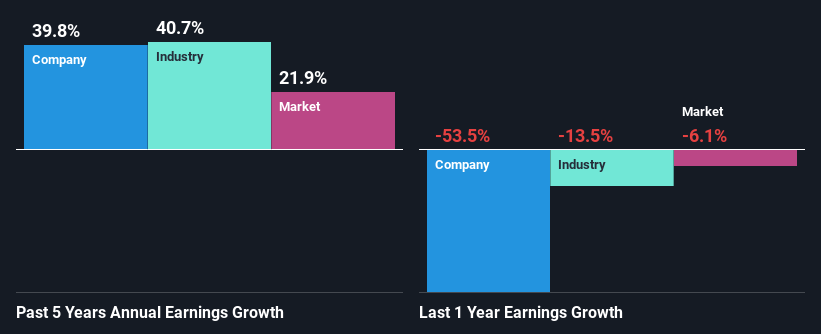Declining Stock and Solid Fundamentals: Is The Market Wrong About Tethys Petroleum Limited (CVE:TPL)?
Tethys Petroleum (CVE:TPL) has had a rough week with its share price down 11%. But if you pay close attention, you might gather that its strong financials could mean that the stock could potentially see an increase in value in the long-term, given how markets usually reward companies with good financial health. In this article, we decided to focus on Tethys Petroleum's ROE.
ROE or return on equity is a useful tool to assess how effectively a company can generate returns on the investment it received from its shareholders. Put another way, it reveals the company's success at turning shareholder investments into profits.
View our latest analysis for Tethys Petroleum
How Do You Calculate Return On Equity?
The formula for return on equity is:
Return on Equity = Net Profit (from continuing operations) ÷ Shareholders' Equity
So, based on the above formula, the ROE for Tethys Petroleum is:
13% = US$5.0m ÷ US$39m (Based on the trailing twelve months to June 2023).
The 'return' is the profit over the last twelve months. That means that for every CA$1 worth of shareholders' equity, the company generated CA$0.13 in profit.
Why Is ROE Important For Earnings Growth?
Thus far, we have learned that ROE measures how efficiently a company is generating its profits. Based on how much of its profits the company chooses to reinvest or "retain", we are then able to evaluate a company's future ability to generate profits. Assuming everything else remains unchanged, the higher the ROE and profit retention, the higher the growth rate of a company compared to companies that don't necessarily bear these characteristics.
Tethys Petroleum's Earnings Growth And 13% ROE
To start with, Tethys Petroleum's ROE looks acceptable. Be that as it may, the company's ROE is still quite lower than the industry average of 20%. Still, we can see that Tethys Petroleum has seen a remarkable net income growth of 40% over the past five years. We reckon that there could be other factors at play here. Such as - high earnings retention or an efficient management in place. However, not to forget, the company does have a decent ROE to begin with, just that it is lower than the industry average. So this certainly also provides some context to the high earnings growth seen by the company.
As a next step, we compared Tethys Petroleum's net income growth with the industry and found that the company has a similar growth figure when compared with the industry average growth rate of 41% in the same period.
Earnings growth is a huge factor in stock valuation. The investor should try to establish if the expected growth or decline in earnings, whichever the case may be, is priced in. Doing so will help them establish if the stock's future looks promising or ominous. Has the market priced in the future outlook for TPL? You can find out in our latest intrinsic value infographic research report
Is Tethys Petroleum Efficiently Re-investing Its Profits?
Tethys Petroleum's three-year median payout ratio is a pretty moderate 33%, meaning the company retains 67% of its income. By the looks of it, the dividend is well covered and Tethys Petroleum is reinvesting its profits efficiently as evidenced by its exceptional growth which we discussed above.
While Tethys Petroleum has been growing its earnings, it only recently started to pay dividends which likely means that the company decided to impress new and existing shareholders with a dividend.
Conclusion
Overall, we are quite pleased with Tethys Petroleum's performance. Particularly, we like that the company is reinvesting heavily into its business at a moderate rate of return. Unsurprisingly, this has led to an impressive earnings growth. If the company continues to grow its earnings the way it has, that could have a positive impact on its share price given how earnings per share influence long-term share prices. Remember, the price of a stock is also dependent on the perceived risk. Therefore investors must keep themselves informed about the risks involved before investing in any company. You can see the 5 risks we have identified for Tethys Petroleum by visiting our risks dashboard for free on our platform here.
Have feedback on this article? Concerned about the content? Get in touch with us directly. Alternatively, email editorial-team (at) simplywallst.com.
This article by Simply Wall St is general in nature. We provide commentary based on historical data and analyst forecasts only using an unbiased methodology and our articles are not intended to be financial advice. It does not constitute a recommendation to buy or sell any stock, and does not take account of your objectives, or your financial situation. We aim to bring you long-term focused analysis driven by fundamental data. Note that our analysis may not factor in the latest price-sensitive company announcements or qualitative material. Simply Wall St has no position in any stocks mentioned.

 Yahoo Finance
Yahoo Finance 
